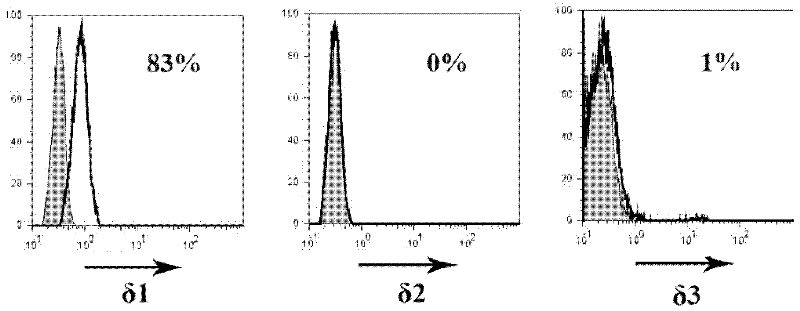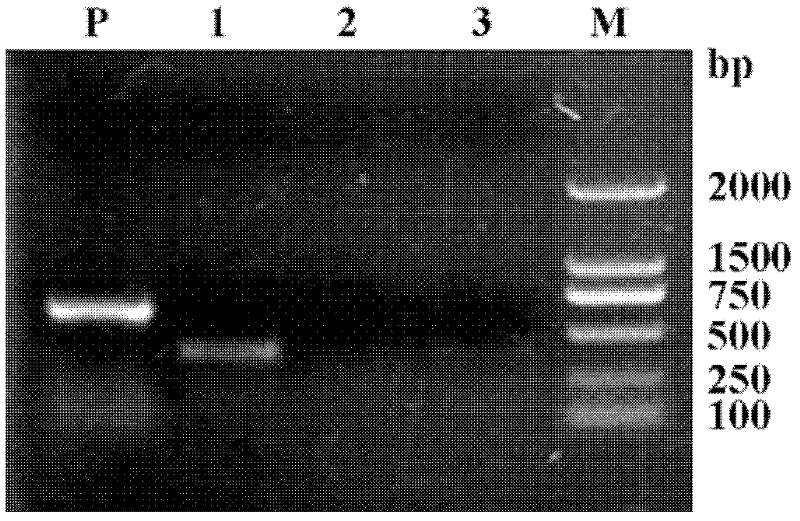Dominant sequence of delta 1 chain complementary determining region (CDR) 3 in gamma delta T lymphocytes, and T cell receptor (TCR) transfected cells and application thereof
A technology of complementarity-determining domains and lymphocytes, which is applied in the field of preparation of drugs for the treatment of malignant tumors, and can solve problems such as inability to represent
- Summary
- Abstract
- Description
- Claims
- Application Information
AI Technical Summary
Problems solved by technology
Method used
Image
Examples
Embodiment 1
[0075] Example 1. Obtaining the dominant sequence GTM of the complementarity-determining domain 3 (CDR3δ1) of the δ1 chain in tumor-infiltrating γδT lymphocytes (tumor-infiltrating γδT cells, γδTIL) derived from human gastric cancer tissue
[0076] 1. Culture and identification of γδTIL cells in epithelial-derived tumors
[0077] 1. Culture of γδ TIL cells
[0078] A 24-well plate was coated with anti-pan-TCRγδ mAb (purchased from Beckman Coulter), 5 μg / well, and incubated at 37° C. for 2 h. Solid tumor specimens (epithelial origin) such as gastric cancer and kidney cancer collected by aseptic surgery were soaked in RPMI-1640 medium (containing penicillin 200 μg / mL, streptomycin 100 μg / mL, gentamicin 100 μg / mL) for 2 time, 10 min / time; remove necrotic tissue, surrounding blood vessels, and normal tissue; cut the washed tissue into small pieces, wash twice with RPMI-1640 medium (containing penicillin 200 μg / mL, streptomycin 100 μg / mL), 10 min / time times, and then resuspended ...
Embodiment 2
[0113] Example 2. Antitumor function and phenotype analysis of γδ1TIL
[0114] 1. The killing function of γδTIL on tumor cells
[0115] Cytotox 96 non-radioactive cytotoxicity assay reagents kit (Promega, USA) was used to perform the killing test according to the instructions of the kit. W2-γδTIL (derived from gastric cancer tissue) and S2-γδTIL (derived from kidney cancer tissue) were used as effector cells to detect their effects on different tumor cells-gastric adenocarcinoma cell BGC-823 (derived from human gastric cancer tissue) and renal cell carcinoma cell G401 (derived from human kidney cancer) and colon cancer cell HT-29 (derived from human colon cancer) killing efficiency. Target cells 1×10 4 Add to 96-well plate per well, so that the effect-to-target ratios are 2.5:1, 5:1, and 10:1, respectively. The result is as Figure 4 As shown (Figure A is the tumor cell killing rate of W2-γδTIL derived from gastric cancer, and Figure B is the tumor cell killing rate of S2-...
Embodiment 3
[0119] Example 3. Predominant Sequence of Complementarity Determining Domain 3 of δ1 Chain in Human Gastric Cancer Tissue-Derived Tumor-Infiltrating γδT Lymphocytes - Binding of CDR3δ1(GTM) Peptide to Tumor Cells, Tumor Tissue, and Vδ1 Ligand Protein MICA
[0120] 1. Synthesis and biotinylation of GTM peptide
[0121] The dominant sequence-CDR3δ1(GTM) peptide of the complementarity-determining domain 3 of the δ1 chain in human gastric cancer tissue-derived tumor-infiltrating γδT lymphocytes shown in SEQ ID NO: 1 in the sequence table was synthesized by chemical synthesis, and a peptide was directly labeled at the end of the synthesis. Biotin molecule, compared to peptide CH3 (WPHNWWPHFKVK) as a control.
[0122] 2. Detection of binding properties of GTM peptides to different tumor cells by flow cytometry
[0123] BGC-823, G401, lung adenocarcinoma cells GLC-82 (derived from human lung adenocarcinoma), HT-29, and human ovarian cancer cells SKOV3 (derived from human ovarian can...
PUM
 Login to View More
Login to View More Abstract
Description
Claims
Application Information
 Login to View More
Login to View More - R&D
- Intellectual Property
- Life Sciences
- Materials
- Tech Scout
- Unparalleled Data Quality
- Higher Quality Content
- 60% Fewer Hallucinations
Browse by: Latest US Patents, China's latest patents, Technical Efficacy Thesaurus, Application Domain, Technology Topic, Popular Technical Reports.
© 2025 PatSnap. All rights reserved.Legal|Privacy policy|Modern Slavery Act Transparency Statement|Sitemap|About US| Contact US: help@patsnap.com



